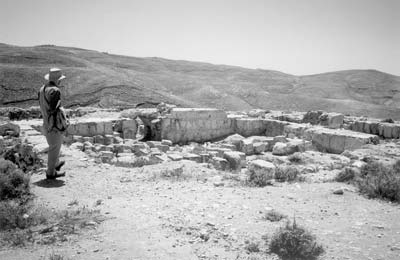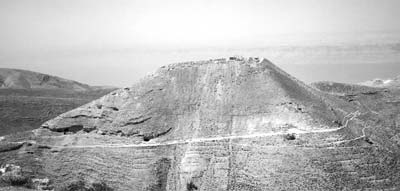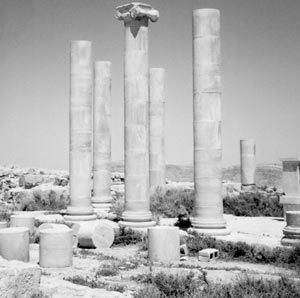Where Salome shed her veils
by Julie Skurdenis
To me, it’s always been one of the most vivid passages in the New Testament.
It’s Herod Antipas’ birthday celebration. Salome, his stepdaughter, dances for him. Herod, entranced, swears he will give her anything she asks for. Salome, prompted by her mother, Herodias, who hates John the Baptist because he has denounced her marriage to Herod (she was divorced from Herod’s brother), asks for the Baptist’s head. John the Baptist is beheaded and his head brought on a platter to Salome and Herodias.
It’s the stuff of great stories, great opera and great paintings. It’s also history.
In the hills of northwestern Jordan not far from the Dead Sea, around 30 B.C., Herod the Great built a palace atop previously existing fortifications. It was in this palace called Machaerus that Herod Antipas, son and successor of Herod the Great, watched Salome dance.
I wanted to see what was left of Machaerus. I knew that it was finally destroyed in A.D. 72 by the Romans, who had captured Jerusalem only two years before.
En route to Machaerus
It’s a 40-mile drive to Machaerus from Amman, Jordan’s capital. The closer you get, the more stark and dramatic the landscape becomes until you reach an area of steep brown hills and sparse vegetation. There are tiny villages and an occasional shepherd swathed in flowing robes tending a herd of sheep or goats.
In front of you suddenly looms a cone-shaped hill with the Dead Sea just beyond. If you squint hard enough, you can just make out the outlines of several columns on top of the hill emerging from the mid-day haze. This is Machaerus.
The road ends abruptly, with the ruins on the hilltop looking very far off. Our driver, Mohamed, assured us that it was not as far as it looked, “only a 20-minute hike, if you are fit.”
‘What if you’re not as fit as you could or should be?,” I thought, as my husband, Paul, and I set off first downhill, then uphill along a pebbly path. But even with the heat and a few short rest stops leaning against remnants of a stone wall, it took me a tad less than 30 minutes to make the climb, husband Paul whispering encouragingly, “Remember Salome.”
When we reached the top, even before I saw the ruins of the palace I was aware of the desolate beauty of this spot. Hills seemed to go on endlessly until they disappeared in a blue-gray haze that I knew was the Dead Sea because Mohamed told us so when we first saw it far off in the distance.
Herod’s Palace
The space on top of this hill is surprisingly small for a palace. It must have been one of Herod Antipas’ more intimate retreats. But, with care, one can trace low walls that were once rooms, although one needs a vivid imagination to picture what these rooms were once used for. Was this a storeroom or a bedroom? Could this have been the kitchen?
The two places we were fairly sure of — in the absence of any information at the site — were the baths, because of the vaulting and the underground rooms that might have held the hypocausts that heated the baths, and the triclinium, which was the Roman dining room.
In the courtyard next to the triclinium a few columns have been erected. They looked brand new. Tradition says that it is here that Salome entertained Herod Antipas. I could visualize her clad in diaphanous veils dancing in this tiny courtyard. I could see Herod Antipas leaning on one elbow on his coach in the triclinium. I could imagine Herodias biding her time waiting for revenge.
The Baptist’s cave
On the way downhill — harder than climbing up because of the slippery loose pebbles on the dirt path — we passed a series of caves, some carved into small rooms with remnants of plaster still remaining on their walls.
Tradition says that John the Baptist was beheaded in one of these caves. There was no one to ask which one it might have been and no signs to tell us. We were totally alone on this desolate hill with just the wind and the ghosts of the Biblical past.
In Mukawir village close to the ruins of the palace is Bani Hamida, a cooperative comprising more than a thousand women from a dozen nearby villages. They produce exquisite, quality products, including weavings, rugs and jewelry.
We missed seeing them at work because our visit to Machaerus fell on a Friday, the Moslem holy day.
The products of Bani Hamida are also sold in Amman at the Jordan River Foundation shop on Fawzi al-Malouf Street.
World Heritage Site
We combined our visit to Mukawir/Machaerus with a visit to Umm ar-Rasas, 20 miles away. Declared a UNESCO World Heritage Site in 2004, Umm ar-Rasas is thought to be the Old Testament city of Mephaath.
Here 15 churches have been discovered so far, including the Church of St. Stephen whose eighth-century mosaic floor depicts cities in Egypt, Palestine and Transjordan. In Greek letters, you can make out Alexandria, Jerusalem, Philadelphia (present-day Amman) and Kastron Mefaa (present-day Umm ar-Rasas).
To reach Mukawir/Machaerus and Umm ar-Rasas, it’s best to hire a car and driver. Our excursion was arranged for us by FreeGate Tourism (585 Stewart Ave., Ste. 310, Garden City, NY 11530; 800/223-0304, www.freegatetours.com) before we left home (Nov. ’06, pg. 102). Arrangements can also be made for you by your hotel in Amman.




